The Eredivisie has always been home to many young stars. From the time of Johan Cruyff until recently with names like Liverpool‘s new signing Cody Gakpo, Frenkie de Jong, among many other players who are developing better every day in the Dutch top-flight. Jurrien Timber has been one of the most prominent names in the news lately since he has been playing regular football at 21. Ajax’s central defender is one of the most sought-after players in this position, especially by Manchester United last summer.
However, there isn’t that constant talk in the world of football about his brother, Quinten. The 21-year-old midfielder has shown, in his regularity in the starting eleven for Feyenoord, to be a key player in Arne Slot’s team to stay at the top of the table.
Facing the lack of opportunities received at Ajax where he started to develop as a player after joining the academy in 2014, Quinten Timber looked forward to a new opportunity in his local league, leaving Utrecht for free in 2021, where he made his professional debut and called so much attention so that he was signed for 8 million euros by Feyenoord in the next season, which is the current 2022/23 season, becoming a key midfielder.
In this tactical analysis, in the form of a scout report, we will review the virtues of Quinten, who at 21 years old shows that he has both offensive and defensive attributes that are quite interesting, within the tactics of Arne Slot’s team.
Pressure-retention
To start the analysis, we have to rOne of the skills that stands out the most within Quinten Timber’s style of play is his ability to retain, shield and save the ball in moments under pressure, where he has a number of extremely interesting resources, including body feints, oriented touches, spins and dribbles to escape the tight space. He is an extremely difficult player to dispossess as a rival. Not only because of the exceptional technique that he demonstrates with a lot of quality in his performances, but also physically he has a very strong lower body that rival players find difficult to break. It is the exact and necessary combination for a player who knows how to escape from these situations.
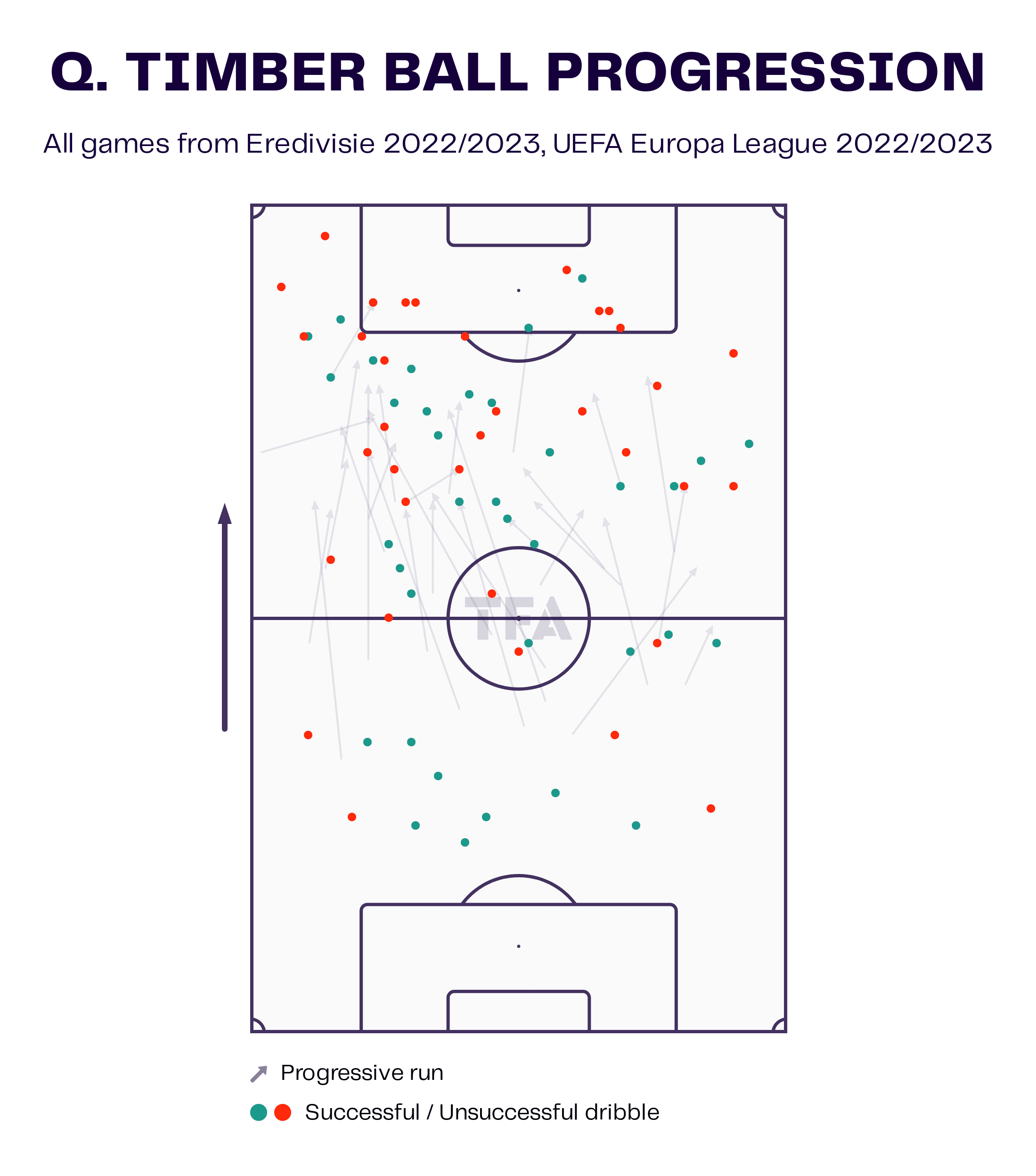
Figure 1 shows how progressive Timber can be, supported by a fairly large number of dribbles on the pitch. He is a player who dynamises many possessions with his touches and his escapes from pressure. Even in high-performance matches in European competitions like the UEFA Europa League, where he has played for Feyenoord this season, without any kind of nervous signs on him, being very brave to look for the ball.
However, we are going to go deeply into what Timber can offer in low areas, where he normally overcomes the pressure thanks to his technical, physical and cognitive qualities, such as his previous scan of all the situations over the pitch, which makes him a midfielder with fantastic intelligence about where to step and where to direct his game after his touches.
In all thirds of the field, he knows how to handle these types of moments of rival aggressiveness with behaviours of great composure, calm and mental superiority when the rival player comes up to try to take the ball away from him quickly. They can even reach two to three players to try and steal the ball from him, and his calmness is still the key. He is not nervous or stressed at any time and his main objective is to get out of there and later, carry the ball several meters, or make forward passes so that his team advance several metres.
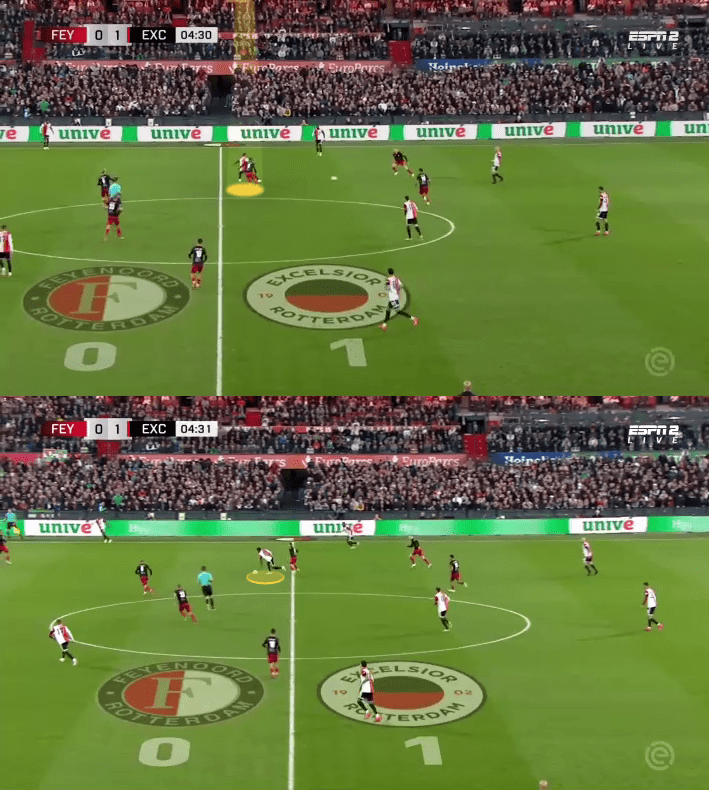
In this sequence, we can see the first example of how Timber has overcome a moment of pressure. His body posture is everything in this play and is the key to why he successfully leaves behind his marker.
He recognises that he only has one player nearby that can press him after receiving, yet he asks for the ball in that area, but places his body open with his back to the player and to the side where he wants to progress. When the ball moves in front of him, he uses his body in a great way, with his arms open to give balance, without making a foul, and does not allow the opponent to stretch his leg to dispossess him, so he comes out with much superiority and later carries the ball a few metres.
The interesting thing about all this is that technically he can receive to the foot, and also solve. But this time, he decided to let the ball roll without him offering more than a very soft touch in order to focus on winning the physical battle against the opposing player, to progress over the middle third.
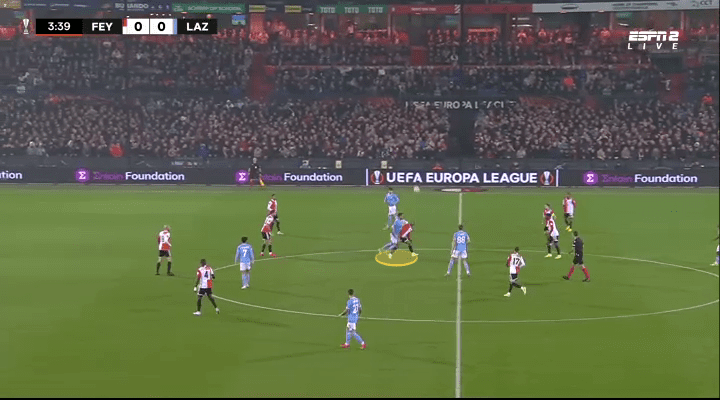
Again, an example of how he knows how to use his body to retain the ball. In a second-play action, Timber finds himself in a physical duel against a rival from Lazio, who seeks to fight tight with him the ball that is bouncing across the halfway line. He quickly recognises what is happening and manages to get ahead of him, thus having the best chance of winning first because of this.
His lower-body use in this play is magnificent as he just put all his strength there to hold the ball. By having a man on top of him, he has little time to see the options he has in front or at his side to progress, but he still decides in a good way, turning the opponent completely and touching the ball behind with his central defender
In addition to knowing how to use his strong build, he is a player who offers body feints and dribbling without using the ball which are very useful to get out of pressure. He can normally wait for the pressure nearby, but if the opponent hasn’t gotten that close yet, he tries to feint with cuts to one side or the other trying to open up a space towards the area where he wants to progress. Sometimes he wants to go to one place, he cuts to the other to clear the main angle he wanted to go to.
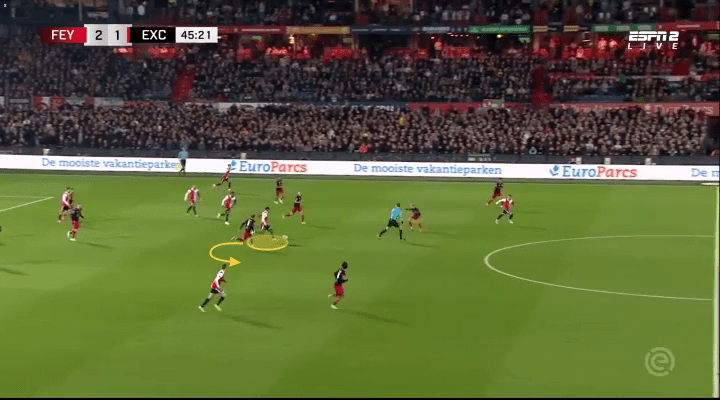
Technically, it is not far behind. In fact, it is the way in which he most seeks to leave behind enemies who try to take the ball away from him quite aggressively.
In the figure we have above, Timber recognizes that he has a player marking him on his skilful side, as he’s right-footed. He knows that he cannot go through there or at least, it’s risky and more so in a quick build-up like this with many rival players in their third. So he makes a spin, something that is highly used by him in these small spaces, to go to the area he wants.
Normally, like everything within his style of play, the spins are of high precision and speed in their executions, as well as carrying a simplicity with them in which he offers the necessary touches and does not hold the ball too much. Despite the fact that he is an excellent player shielding it, he does not abuse it and always wants to release the ball quickly.
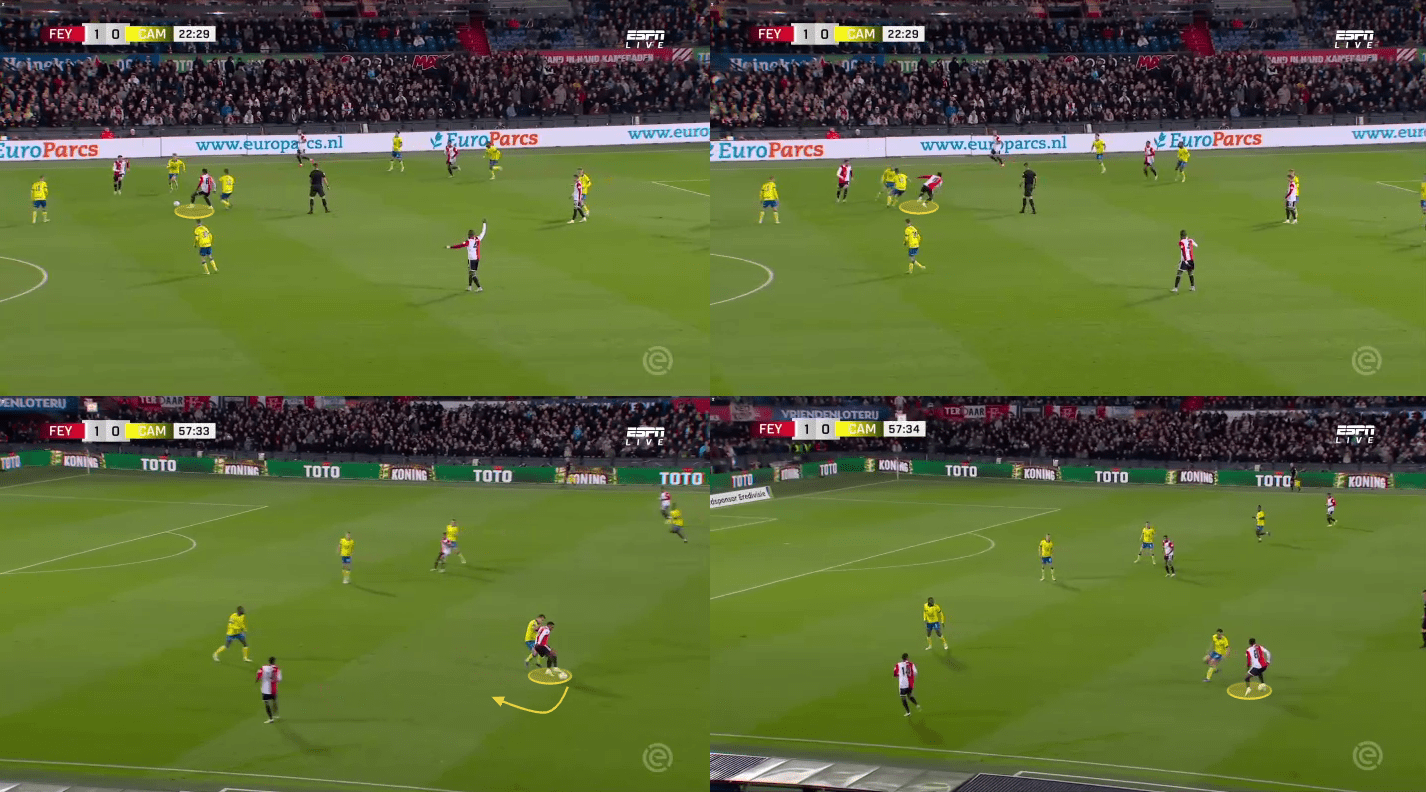
The image above makes it even clearer what Timber can do under pressure. In the first two examples, we can see how he is closely marked by two players, one from the front and one from the back. But the 21-year-old midfielder has already recognized what he wants and what he is going to do to get out of there, so he calls for the ball in a loaded, dangerous area but feels confident. And he solves this in a great way, with his left foot, which he uses well. He offers an oriented touch forward that makes him advance metres in a second with time and space, greatly upsetting the rival. All also thanks to his body posture prior to the touch. In his simplicity, there is an art.
In the two examples below, we can find how he solves such a situation in a more advanced area of the pitch. Everything starts from a run of him in-behind that he tried. His partner’s pass is not to space but to the foot, for which he must resolve. He is playing with his back to the goal, something that he does not constantly look for, he holds the opponent with his body and then performs a turn of great aestheticism. After that, he confronts the opponent in a 1v1 and feints with a cut to the left and then opens up to his right to create an angle of passing where he wanted and finds a teammate after attacking the half-space with an unmarked run.
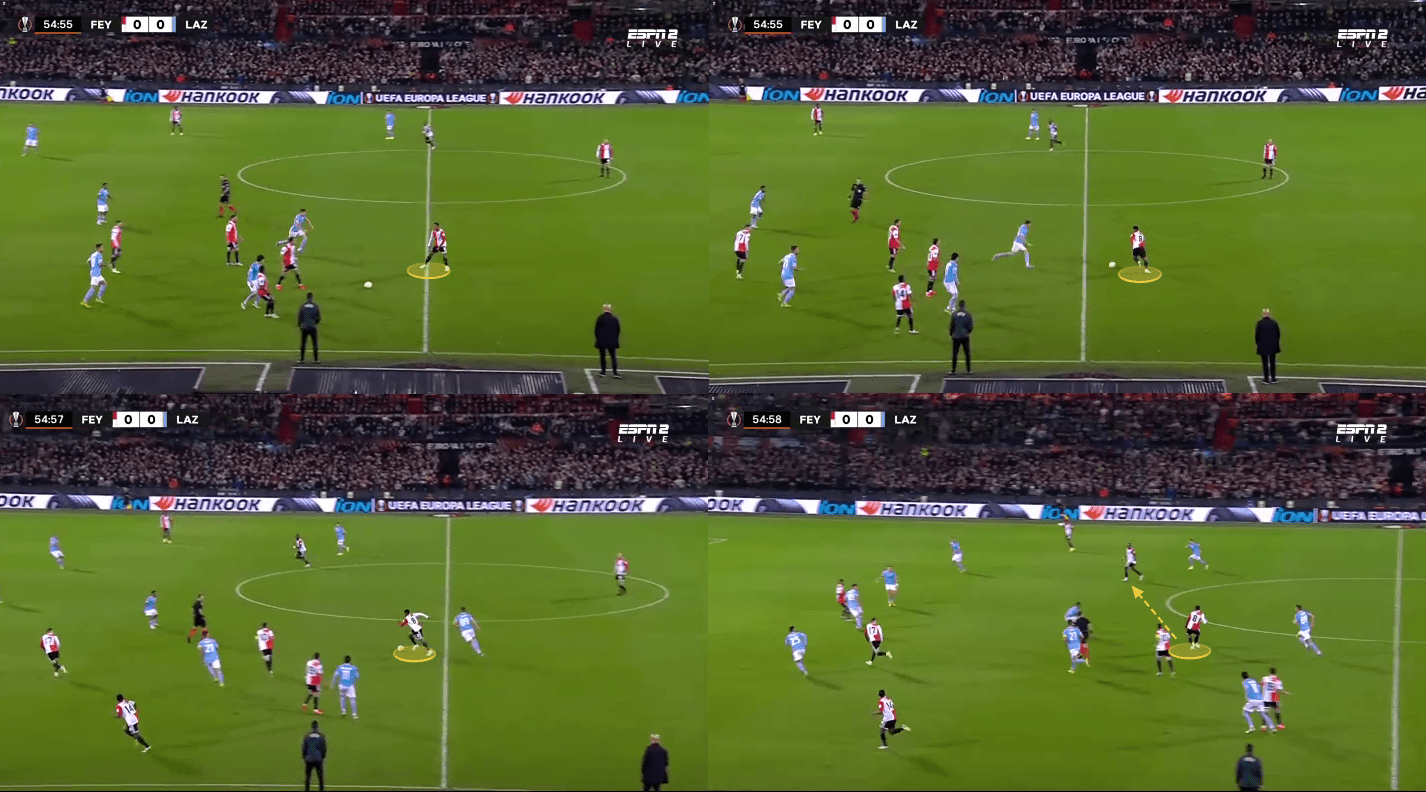
His dynamisation of possessions with simple touches or body posture can be seen in this magnificent play. Quinten looks to ask for the ball from his partner who was facing a marking situation in wide areas, so he offered himself as support. When he receives the pass, he awaits the ball in front of where he was released. Consequently, he fully turns his body to his right side, where he has plenty of room to progress. He decides for himself to carry the ball with great power, runs at the rival player with physical superiority and in a matter of 3-5 seconds places his team in the last third of the field with a progressive pass after his previous evasion of pressure.
The way in which, technically and physically, he solves these types of play is very special for a footballer since not all midfielders are capable of this. His low centre of gravity, combined with his strong and wide lower body is the perfect mix for a player who bravely escapes pressing holes and asks for the ball in little spaces.
Passing and intelligence
Quinten Timber is a footballer who stands out in his passing due to how dynamic he is as soon as he receives the ball. After making contact with the ball, the pass travels extremely fast from his foot to the receiver. He is constantly looking to find wide teammates, with receptions at the foot rather than to space, and that he can later accompany with interesting movements to create quick combinations through the middle.
Timber’s main asset with the ball is how quickly he recognises a possible passing lane and how fast the ball is released from his foot. He can, since he makes the decision to pass, take just one second or less to throw the ball to a teammate. He offers one or two touches prior to the execution. All this was without being under pressure since, as we could see, he is a footballer who retains well and is extremely agile to think and make decisions.
First of all, you have to know which areas of the field Timber dominates before controlling the ball. He normally plays as a midfielder in the right half-space, but he is comfortable even playing on the left. He has the ability to play as a lone pivot as well as in a more advanced role.
It should be noted that Timber is not a midfielder to orchestrate and dictate the tempo of a team’s possession, since he is a player with a simple style, who releases the ball rapidly and wants to reach the last third, with good decisions, but with less calm in their executions than other midfielders with more control tend to offer. That is why his role within Feyenoord is that of a “box-to-box” so to speak, although not completely.
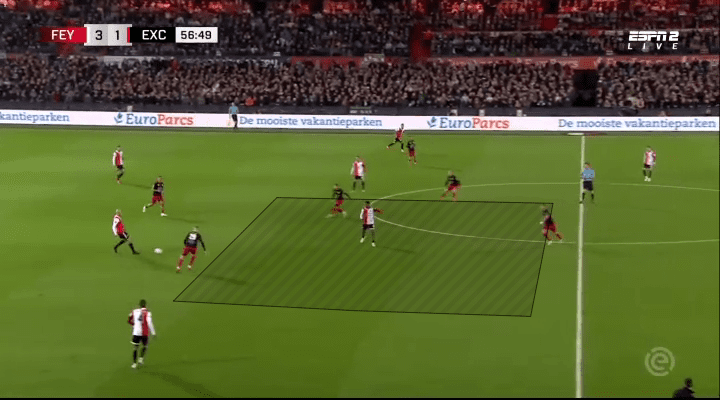
One of the most important and positive things in Timber’s game is that he is extremely intelligent in action, and all this comes from his constant scanning on the pitch. Before asking for the ball, receiving it and doing something with it at his feet, he already has all the paths clear. He has seen all possible areas, rivals and teammates. He is extremely attentive to every detail and before receiving the pass, he already knows what the next one will be. He takes very little time to think with the ball.
It’s unusual to see him play with his back facing the rival goal, but when he does, he’ll scan the area where he wants to move or progress up to three or four times to see what he’ll do after receiving.
His hips are quite elastic, which allows him to turn his body quickly and naturally. So he doesn’t have to stress about that, instead, he searches where to go and pass very much to take the best decision, and if he can’t progress, he doesn’t seem to have a problem playing the ball to the sides or back. However, in the figure below, he scans the options behind him and then turns his body and decides to play a pass between the lines to the central channel, where a teammate has asked for the ball.
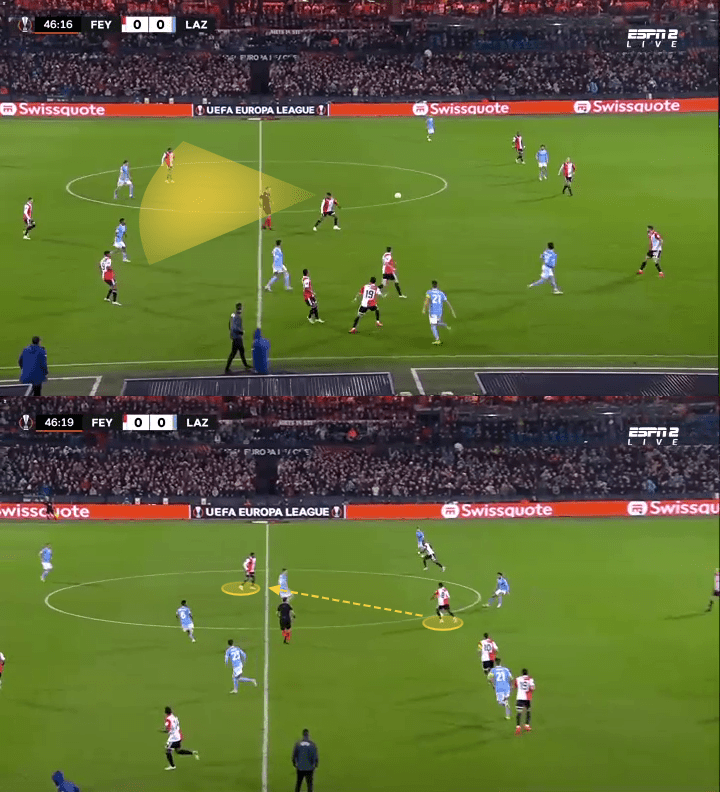
Quinten is not one to break many lines through the middle, both due to a tactical request to look outside, and also because he prefers to make quick plays with closer players. So this type of passes from behind that some midfielders make, looking for faraway players who detect small pockets of space for their receptions to create danger between the lines, is not something he is looking for. He prefers the 1-2 combination on many occasions.
However, it is more than clear that in some plays, where he decides to do things that he rarely tries, he does it with great technique and with a forceful decision. This is something positive in him since, for the things in which he is not yet so prominent, he seeks to do little of, and if they start to happen in a good way, he does them more regularly. He gives things time to grow.
He is a midfielder with little doubt in his actions and this is extremely class since at this age, it is normal for it to be an aspect in which the player must grow.
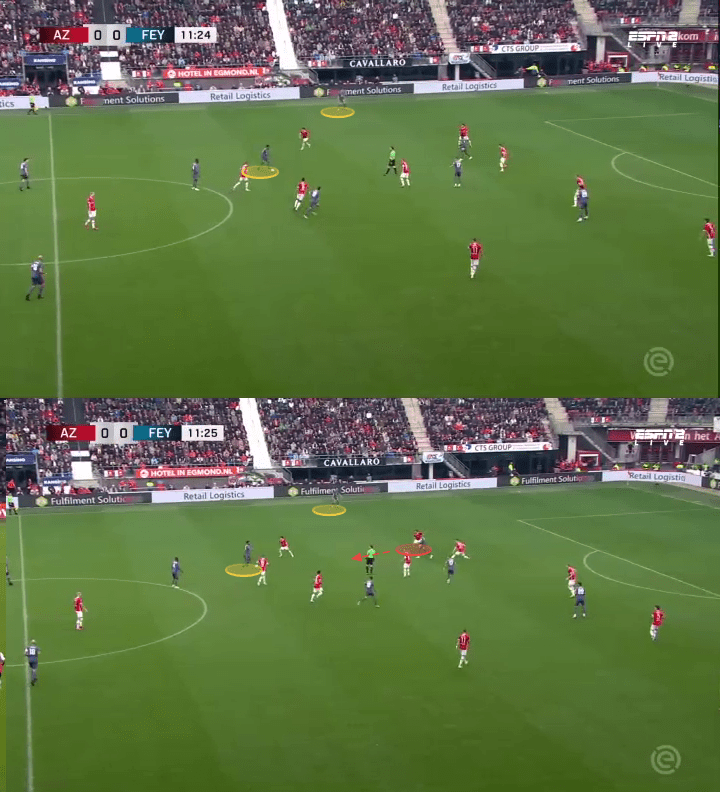
This is a perfect play to test his intelligence and how good he is with the pass. Despite the fact that he is a player who seeks to move the ball up more to the sides and release it fast, this comes in a great way for Feyenoord who look to start plays from the inside to out and finish them the other way around.
In the image, we can see how Timber has the ball in the left half-space, with his LB wide open hugging the line. Despite the fact that he already has the space to execute, with a lot of calm and patience, he looks to attract the rival line, specifically the right back, which, seeing that Timber thinks about the execution too much, he jumps to defend and opens much more space behind him. That’s where the Feyenoord midfielder executes the pass outside.
This is a great example and demonstration of how smart he can be on the ball. Despite already having the passing lane, he thinks that it was possible to create more space and time for his teammate out wide. So he even played with the opponent, pointing where the pass was going, challenging him and forcing him to make an impulsive decision that he took advantage of.
To end this section, let’s see a map of his progressive passes this season at the Eredivisie. Many of them are looking to open up the wings, but others as well trying to look for the penalty box.
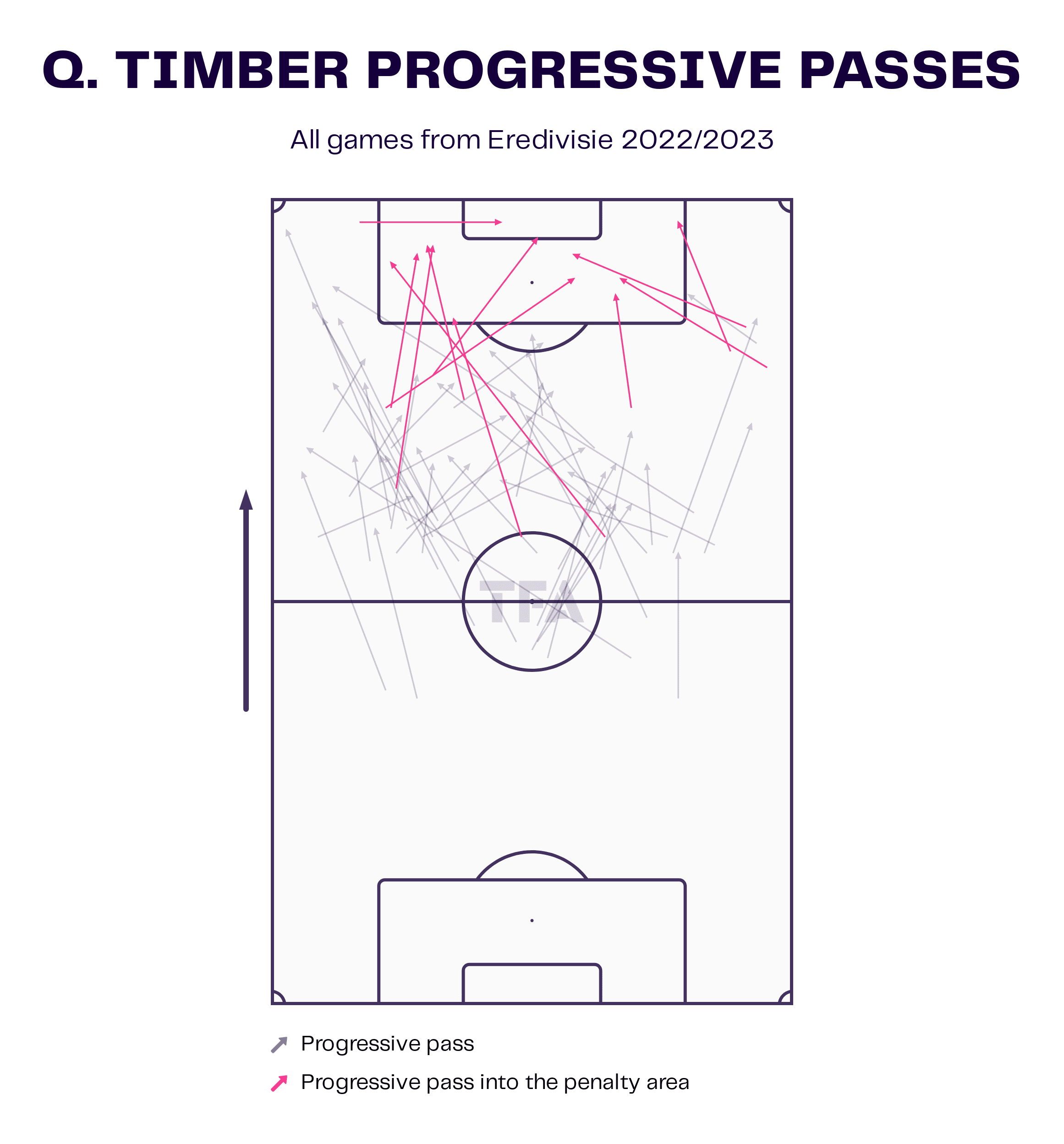
Ball-carrying and creating chances
Despite releasing the ball quickly, Timber recognises spaces that he can run to advance more metres and then decide what he is going to do and when he will make the pass. They are ball carries of a few seconds, also due to the physical power that he has to gallop over the thirds, which always ends with a pass. However, the aggression in them and the intelligence to move his team if he sees spaces is quite noticeable.
His ball-carrying ability is quite good and he creates a lot of threat for his team, as he moves the ball from even the halfway line to the final third. In the image below, we can find Quinten behind even the centre of the pitch, and seven seconds later he has reached the final third, making a pass to his wide winger who will later face 1v1 duels against the defender.
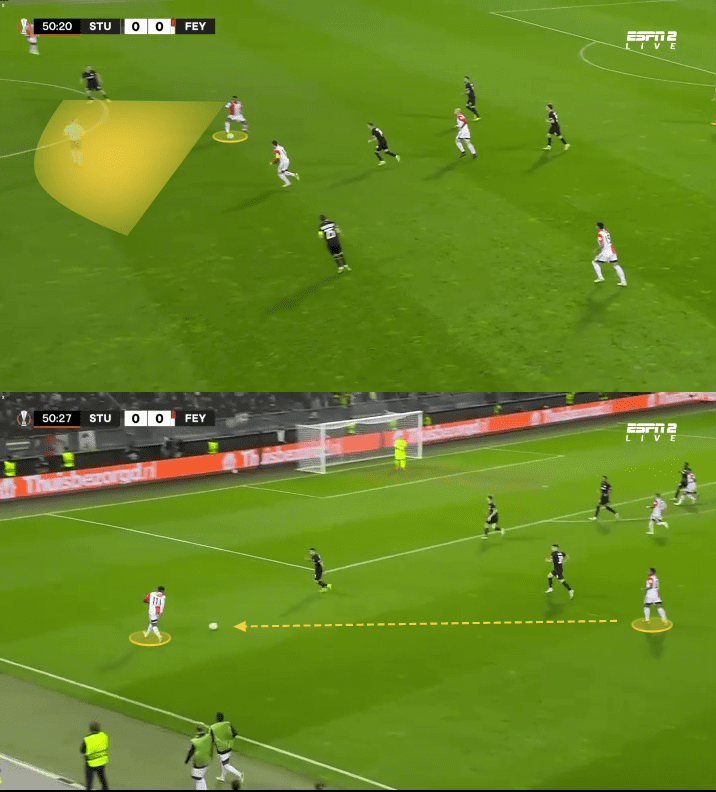
Again, Timber is very agile at thinking about what he has to do. He raises his head and recognises spaces that he can run into, which he does not hesitate for a second and begins to do so, with some changes of direction that make him confuse the rivals, despite the fact that his ball-carrying is more to move the team forward and stay there than to penetrate aggressively the rival box.
The figure below is, once again, another example that perfectly highlights him in this attribute that he has as well. He takes the ball in front of the halfway line, where he is quite comfortable receiving. He visualizes the spaces around him and knows that he has ground to run and time to do it, so he contributes to his team with the carry and reaches the last third to find the wide winger again.
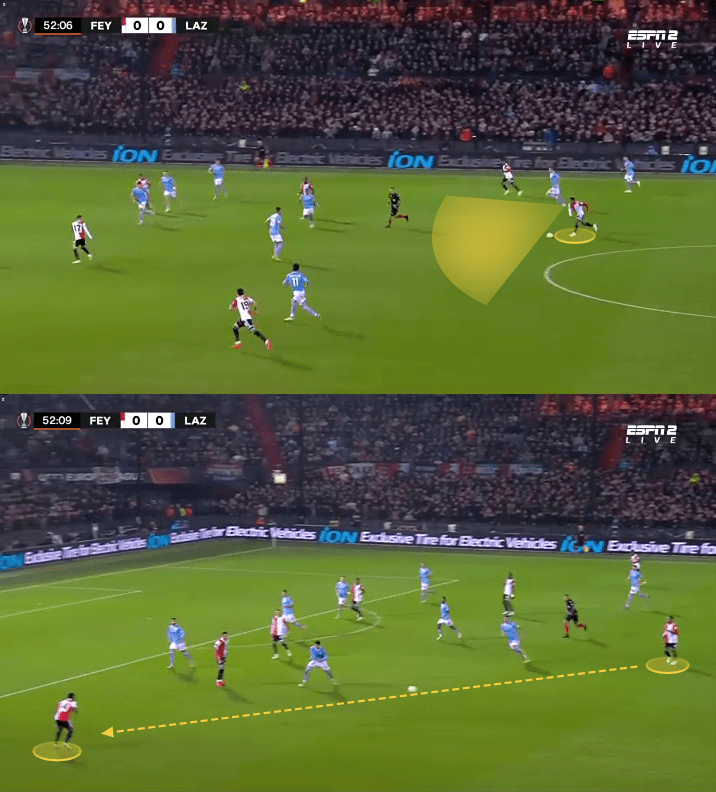
When he gets close to the penalty box, he is a dangerous player, because the ball seems to be stuck under his feet. He can handle it from one to the other and evade rivals until he reaches the box, as well as his confidence to play 1-2 combinations fast on the edge of the box, where his teammates offer him very dynamic receptions and passes that make him step on the rival penalty area and cause a shot from him or a pass that later ends in a shot or goal.
The threatening plays he generates are almost always similar to what we see in the figure below: Timber is on the edge of the box, and he has close passing options that help him create these 1-2 plays with players of good hold-up and link-up play in that area. There he always offers support movements after releasing the pass so that he is the one who receives with an unnmarking movement and reaches the rival box where he usually seeks to finish it off with a shot. This could maybe be a thing to get better on, the finishing. Not just for the technique he looks to apply in it, but when to take the strike and the direction of it.
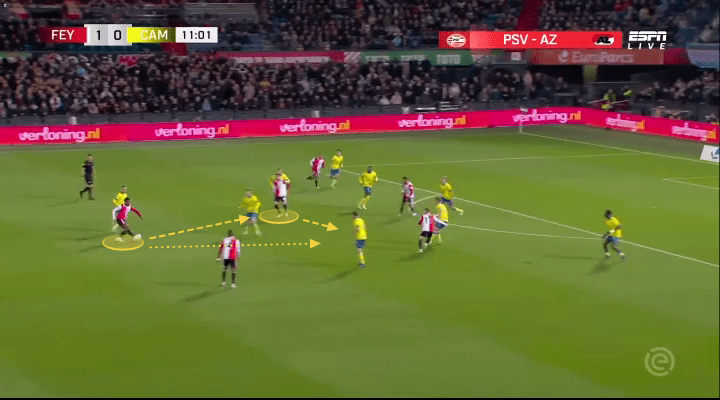
However, it not only adds these types of plays to the edge of the area that can be difficult for the opponent to defend, but he also tries to find players making moves to attack the last defensive line, as we can see in the example below. It is something in which he could improve much more as well, to wait and use the subsequent pass to look for a teammate in space.
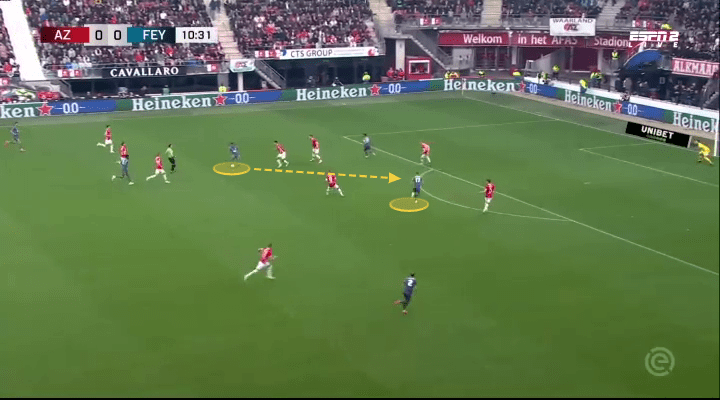
Conclusion
It is clear that Quinten Timber has many virtues and positives that make him a quite skilled and capable midfielder with the ball, as this analysis has shown, but he must improve certain defensive aspects such as the timing of his tackles, the reading of the game to cut passes or press at the moment that he has to, as well as in the number of the fouls he creates.
Defensively, his positioning is still good, but in his timing to jump and cutting technique, he should be better. However, what he offers as a progressive footballer with the ball is brilliant in many of his decisions and provides effectiveness plus danger-creation to his team, in addition to his best facet, which is how easy it is for him to evade the press.
If he improves a few details, he can quickly become a top midfielder, to play in a better team and league.






Comments